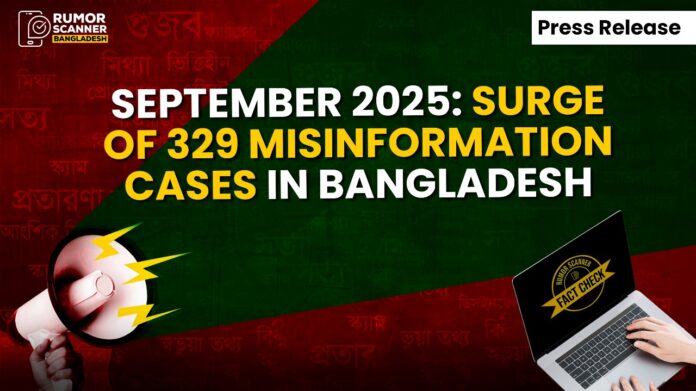In September of this year, Rumor Scanner, a Bangladeshi fact-checking organization, identified 329 pieces of misinformation that had spread across the internet. Political topics accounted for the vast majority (229) of the misinformation, which is approximately 70% of the total number of misinformation counted from the fact-checks published on Rumor Scanner’s website in September. Furthermore, 53 pieces of misinformation were identified on national issues, 20 on religious issues, 11 on international topics, five on entertainment and literature, four on education, and seven on sports last month.
Apart from this, two separate statistics were released regarding the DUCSU and JACSU elections and a detailed investigation under the Rumor Scanner Investigation Unit into the spread of disinformation through fake verified accounts using the name and photo of a female news anchor was published last month.
In these incidents, video-based misinformation was the most frequent, totaling 215. Additionally, there were 79 instances of text-based misinformation and 35 instances of image-based misinformations. Of the identified misinformation, 233 incidents were categorized as false, 33 as distorted, and 63 as misleading.
Analyzing the identified misinformation, Rumor Scanner found that during this period, 201 pieces of misinformation involved men, and 85 involved women.
During the same period, the misinformation was divided into four categories based on age demographics. The analysis shows that the highest number of false claims (113) were spreads about young adults (aged 18 to 35 years). Furthermore, 5 pieces of misinformation involved children (aged 0 to 17 years), 73 involved middle-aged individuals (aged 36 to 59 years), and 90 involved the elderly (aged 60 years or more).
In terms of platforms, the highest amount of misinformation spread on Facebook last month, totaling 289 incidents. Additionally, evidence was found of at least 156 pieces of misinformation spreading on Instagram, 46 on YouTube, 40 on X, 82 on TikTok, and 13 on Threads. The country’s media outlets were not excluded from the list of misinformation propagators either. Rumor Scanner observed the spread of misinformation in a significant number of domestic media outlets across 13 incidents. During the same period, two instances of disinformation concerning Bangladesh were also identified in Indian media outlets.
The issue of communal disinformation targeting Bangladesh has been a topic of discussion for the past several months. In September, Rumor Scanner identified 15 pieces of communal disinformation. Among these, evidence was found in eight incidents that the disinformation was spread from social media accounts and pages identifying as Indian.
The Rumor Scanner team’s observation found that six pieces of misinformation were spread in September concerning the current interim government. To understand the nature of this misinformation, Rumor Scanner divided it into two separate categories. Considering the promotion of misinformation that favors the government as positive and the promotion of misinformation that goes against it as negative, Rumor Scanner observed that the government was presented negatively in all of these pieces of misinformation.
Last month, 16 pieces of misinformation were spread about the Chief Advisor of the interim government, Dr. Muhammad Yunus, and he was presented negatively in all of them. Furthermore, among the government’s advisors, six pieces of misinformation involved Jahangir Alam Chowdhury, two each involved Dr. Asif Nazrul, Asif Mahmud Sajib Bhuiyan, and Syeda Rizwana Hasan, and one involved Mahfuj Alam. All of these instances of disinformation presented them negatively.
The Thirteenth National Parliament Election is a hot topic of discussion everywhere. The spread of disinformation centered around this election has increased significantly over the past few months. Ten instances of such disinformation were identified in September.
Analyzing the fact-checks from September, Rumor Scanner found that among the political parties currently active, the highest number of disinformation (69) was spread involving Bangladesh Jamaat-e-Islami, its affiliates, and activists. Within this, 11 pieces of disinformation were spread directly involving the party, Jamaat. In nearly 91 percent of these cases, the information created an opportunity for a negative perception of the party. During this time, two pieces of disinformation (both negative) were spread involving the party’s Amir, Dr. Shafiqur Rahman. Thirty-six pieces of disinformation (nearly 92 percent of which were negative) were spread in September involving the party’s student wing, Bangladesh Islami Chhatra Shibir.
Following Jamaat, the next highest amount of disinformation (68) was spread involving the Bangladesh Nationalist Party (BNP), its affiliates, and activists. Within this, 22 pieces of disinformation were spread directly involving the party, BNP, all of which created an opportunity for a negative perception of the party. During this period, four pieces of disinformation (75 percent of which were negative) were spread concerning the party’s Acting Chairman, Tarique Rahman. Additionally, 18 pieces of disinformation (all negative) were spread involving the Jatiyatabadi Chhatra Dal (Student Wing) and one (negative) involving the Jatiyatabadi Juba Dal (Youth Wing) during this time.
In addition, Rumor Scanner identified 23 pieces of disinformation in September involving the National Citizen Party (NCP) and its activists. Within this, two pieces of disinformation were spread directly involving the party, NCP, both of which created an opportunity for a negative perception of the party. During this period, one piece of disinformation (negative) was identified concerning the party’s Convener, Nahid Islam.
The Bangladesh Awami League, a party whose activities have been suspended/prohibited, its affiliated and fraternal organizations, and its activists were the subjects of 145 pieces of disinformation in September. Among these, 64 pieces of disinformation were spread involving the Awami League as a party, nearly 98 percent of which created an opportunity for a positive perception in their favor. Evidence was found that 23 pieces of disinformation (all positive) were spread during this time concerning the party’s president, Sheikh Hasina. Additionally, 18 pieces of disinformation (94 percent positive) were identified last month involving the party’s now-prohibited student organization, Bangladesh Chhatra League, and five pieces of disinformation (all positive) involving the Juba League.
State forces are also not safe from the fury of misinformation. In September, Rumor Scanner observed the spread of 25 pieces of misinformation involving the Bangladesh Army, including six pieces directly related to the Army Chief, General Waker-uz-Zaman. Furthermore, Rumor Scanner identified 23 pieces of misinformation involving the Bangladesh Police, 6 involving the Border Guard Bangladesh (BGB), 2 involving the Bangladesh Air Force, and one each involving the Bangladesh Navy and the Rapid Action Battalion (RAB).
Analyzing the misinformation identified in September, Rumor Scanner found that 18 pieces of fake content were created using Artificial Intelligence (AI) during this period. Over the same time, 13 instances of deepfake content were identified.
In September, there was a spread of misinformation across seven events or issues. A flow of misinformation was observed regarding the DUCSU election on September 9, the JUCSU election on September 11, Durga Puja, the Asia Cup, the UN General Assembly session, the Khagrachari violence, and the JAPA-GOP conflict on August 29. Among these, the DUCSU election saw the maximum spread of misinformation (43). Additionally, 20 pieces of misinformation were identified regarding the Khagrachari violence issue, 14 regarding the JUCSU election, 13 concerning Bangladesh’s participation in the UN General Assembly session, five each on the Durga Puja and Asia Cup issues, and two on the JAPA-GOP conflict issue.
The amount of misinformation being spread using the names, logos, headlines, and fake/duplicate photocards of media outlets is again seeing an increase. In September, this method was used to spread 33 pieces of misinformation across 33 incidents, involving 15 domestic news media organizations.
Issued by
Tanvir Mahatab Abir
Senior Fact Checker,
Rumor Scanner Bangladesh






